Strategic Planning Analysis: Chinese Cultural Organizations
VerifiedAdded on 2022/03/15
|10
|4086
|27
Report
AI Summary
This report examines strategic planning within Chinese cultural organizations, specifically focusing on museums and galleries. It explores the application of strategic planning principles, including PESTLE and SWOT analyses, within the context of cultural institutions in China. The report delves into how political, economic, socio-cultural, technological, legal, and environmental factors impact these organizations. It also reflects on the author's internship experiences, highlighting the strengths and weaknesses of a Chinese museum. Furthermore, the report considers the implications of these observations for future leadership roles within cultural organizations in China. The analysis covers the impact of government policies, economic trends, cultural festivals, technological advancements, legal regulations, and environmental considerations on the strategic planning process, providing a comprehensive overview of the challenges and opportunities faced by these institutions.
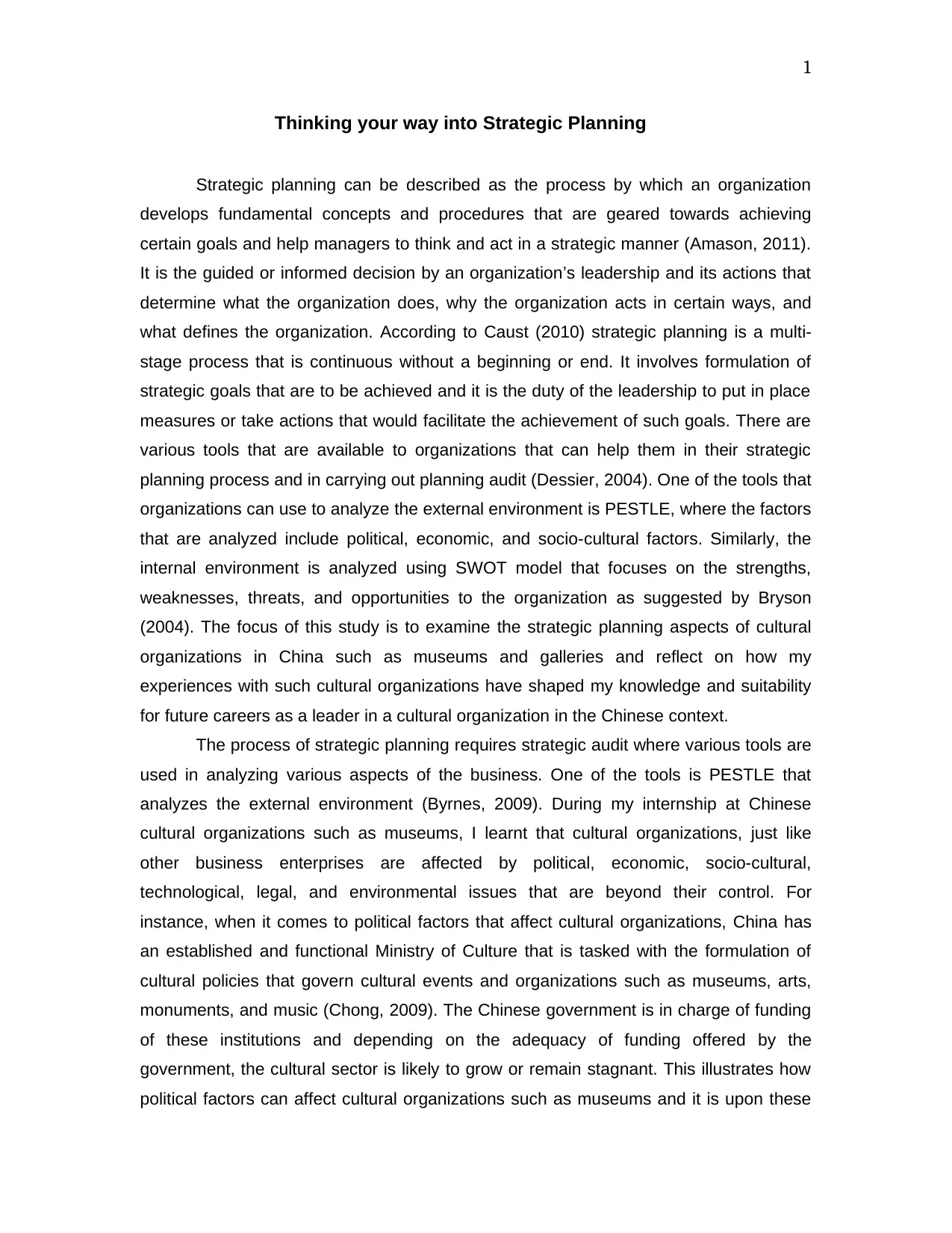
Thinking your way into Strategic Planning
Strategic planning can be described as the process by which an organization
develops fundamental concepts and procedures that are geared towards achieving
certain goals and help managers to think and act in a strategic manner (Amason, 2011).
It is the guided or informed decision by an organization’s leadership and its actions that
determine what the organization does, why the organization acts in certain ways, and
what defines the organization. According to Caust (2010) strategic planning is a multi-
stage process that is continuous without a beginning or end. It involves formulation of
strategic goals that are to be achieved and it is the duty of the leadership to put in place
measures or take actions that would facilitate the achievement of such goals. There are
various tools that are available to organizations that can help them in their strategic
planning process and in carrying out planning audit (Dessier, 2004). One of the tools that
organizations can use to analyze the external environment is PESTLE, where the factors
that are analyzed include political, economic, and socio-cultural factors. Similarly, the
internal environment is analyzed using SWOT model that focuses on the strengths,
weaknesses, threats, and opportunities to the organization as suggested by Bryson
(2004). The focus of this study is to examine the strategic planning aspects of cultural
organizations in China such as museums and galleries and reflect on how my
experiences with such cultural organizations have shaped my knowledge and suitability
for future careers as a leader in a cultural organization in the Chinese context.
The process of strategic planning requires strategic audit where various tools are
used in analyzing various aspects of the business. One of the tools is PESTLE that
analyzes the external environment (Byrnes, 2009). During my internship at Chinese
cultural organizations such as museums, I learnt that cultural organizations, just like
other business enterprises are affected by political, economic, socio-cultural,
technological, legal, and environmental issues that are beyond their control. For
instance, when it comes to political factors that affect cultural organizations, China has
an established and functional Ministry of Culture that is tasked with the formulation of
cultural policies that govern cultural events and organizations such as museums, arts,
monuments, and music (Chong, 2009). The Chinese government is in charge of funding
of these institutions and depending on the adequacy of funding offered by the
government, the cultural sector is likely to grow or remain stagnant. This illustrates how
political factors can affect cultural organizations such as museums and it is upon these
1
Strategic planning can be described as the process by which an organization
develops fundamental concepts and procedures that are geared towards achieving
certain goals and help managers to think and act in a strategic manner (Amason, 2011).
It is the guided or informed decision by an organization’s leadership and its actions that
determine what the organization does, why the organization acts in certain ways, and
what defines the organization. According to Caust (2010) strategic planning is a multi-
stage process that is continuous without a beginning or end. It involves formulation of
strategic goals that are to be achieved and it is the duty of the leadership to put in place
measures or take actions that would facilitate the achievement of such goals. There are
various tools that are available to organizations that can help them in their strategic
planning process and in carrying out planning audit (Dessier, 2004). One of the tools that
organizations can use to analyze the external environment is PESTLE, where the factors
that are analyzed include political, economic, and socio-cultural factors. Similarly, the
internal environment is analyzed using SWOT model that focuses on the strengths,
weaknesses, threats, and opportunities to the organization as suggested by Bryson
(2004). The focus of this study is to examine the strategic planning aspects of cultural
organizations in China such as museums and galleries and reflect on how my
experiences with such cultural organizations have shaped my knowledge and suitability
for future careers as a leader in a cultural organization in the Chinese context.
The process of strategic planning requires strategic audit where various tools are
used in analyzing various aspects of the business. One of the tools is PESTLE that
analyzes the external environment (Byrnes, 2009). During my internship at Chinese
cultural organizations such as museums, I learnt that cultural organizations, just like
other business enterprises are affected by political, economic, socio-cultural,
technological, legal, and environmental issues that are beyond their control. For
instance, when it comes to political factors that affect cultural organizations, China has
an established and functional Ministry of Culture that is tasked with the formulation of
cultural policies that govern cultural events and organizations such as museums, arts,
monuments, and music (Chong, 2009). The Chinese government is in charge of funding
of these institutions and depending on the adequacy of funding offered by the
government, the cultural sector is likely to grow or remain stagnant. This illustrates how
political factors can affect cultural organizations such as museums and it is upon these
1
Paraphrase This Document
Need a fresh take? Get an instant paraphrase of this document with our AI Paraphraser

organizations and their leadership to adjust accordingly to respond to the policies that
the government puts in place (Joncovich, 2015). Similarly, the Chinese government is
very restrictive of freedom of expression through cultural arts and this has seen the
government put in place censorship policies that are meat to stifle certain kinds of arts.
Such strict censorship has seen regulators impose bans on various artistic works such
as The Golden Lotus theatre production that was accused of containing erotic/sexual
content (Morse & Munro, 2015). The reasoning behind government banning the theatre
production was to protect Chinese cultural values. I was able to appreciate the extent to
which government control can limit the success of the cultural organizations through
strict regulations but also promote them through financial support.
When it comes to economic factors that can affect the cultural organizations in
China, they may range from inflation, recession, interest rates, GDP growth rate, and
consumer purchasing power (Holden, 2004). It is important that the management of a
cultural organization such as museum is able to scan the economic environment to
establish those that can affect it and come up with strategies on how it can deal with the
factors in the economic environment as suggested by Gill et al. (2018). One of the
factors that is of interest is GDP growth. China is one of the economies on the world that
has had fast growing economy that has resulted in increasing number of middle-class
consumers as disposable incomes of citizens improve and more employment
opportunities emerge (Varbanova, 2013). As a result, they have adequate incomes to
spend in leisure activities. Cultural events and activities are leisure activities that require
extra income for one to attend for entertainment purposes hence as Chinese citizens
improve in terms of their disposable incomes, the cultural events or organizations get to
register high visitor traffic and booming business as opined by Clare (2009). I was able
to witness this trend during my internship at a Chinese museum where the museum
would register higher numbers of visitors/tourists mainly during the end month seasons
when many workers have earned their salaries hence are able to afford attending leisure
events in cultural organizations. However the customer traffic reduces gradually towards
the last weeks of the month.
When it comes to socio-cultural factors, there are various cultural festivals that
are often organized in China as well as religious festivals. There are also issues of social
class and ethnicity which have an impact on the cultural organizations. As for cultural
organizations, it is upon the leaders to be able to strategize on how they can reap from
the social and cultural trends in China (Bryson & Alston, 2004). For instance, China has
2
the government puts in place (Joncovich, 2015). Similarly, the Chinese government is
very restrictive of freedom of expression through cultural arts and this has seen the
government put in place censorship policies that are meat to stifle certain kinds of arts.
Such strict censorship has seen regulators impose bans on various artistic works such
as The Golden Lotus theatre production that was accused of containing erotic/sexual
content (Morse & Munro, 2015). The reasoning behind government banning the theatre
production was to protect Chinese cultural values. I was able to appreciate the extent to
which government control can limit the success of the cultural organizations through
strict regulations but also promote them through financial support.
When it comes to economic factors that can affect the cultural organizations in
China, they may range from inflation, recession, interest rates, GDP growth rate, and
consumer purchasing power (Holden, 2004). It is important that the management of a
cultural organization such as museum is able to scan the economic environment to
establish those that can affect it and come up with strategies on how it can deal with the
factors in the economic environment as suggested by Gill et al. (2018). One of the
factors that is of interest is GDP growth. China is one of the economies on the world that
has had fast growing economy that has resulted in increasing number of middle-class
consumers as disposable incomes of citizens improve and more employment
opportunities emerge (Varbanova, 2013). As a result, they have adequate incomes to
spend in leisure activities. Cultural events and activities are leisure activities that require
extra income for one to attend for entertainment purposes hence as Chinese citizens
improve in terms of their disposable incomes, the cultural events or organizations get to
register high visitor traffic and booming business as opined by Clare (2009). I was able
to witness this trend during my internship at a Chinese museum where the museum
would register higher numbers of visitors/tourists mainly during the end month seasons
when many workers have earned their salaries hence are able to afford attending leisure
events in cultural organizations. However the customer traffic reduces gradually towards
the last weeks of the month.
When it comes to socio-cultural factors, there are various cultural festivals that
are often organized in China as well as religious festivals. There are also issues of social
class and ethnicity which have an impact on the cultural organizations. As for cultural
organizations, it is upon the leaders to be able to strategize on how they can reap from
the social and cultural trends in China (Bryson & Alston, 2004). For instance, China has
2
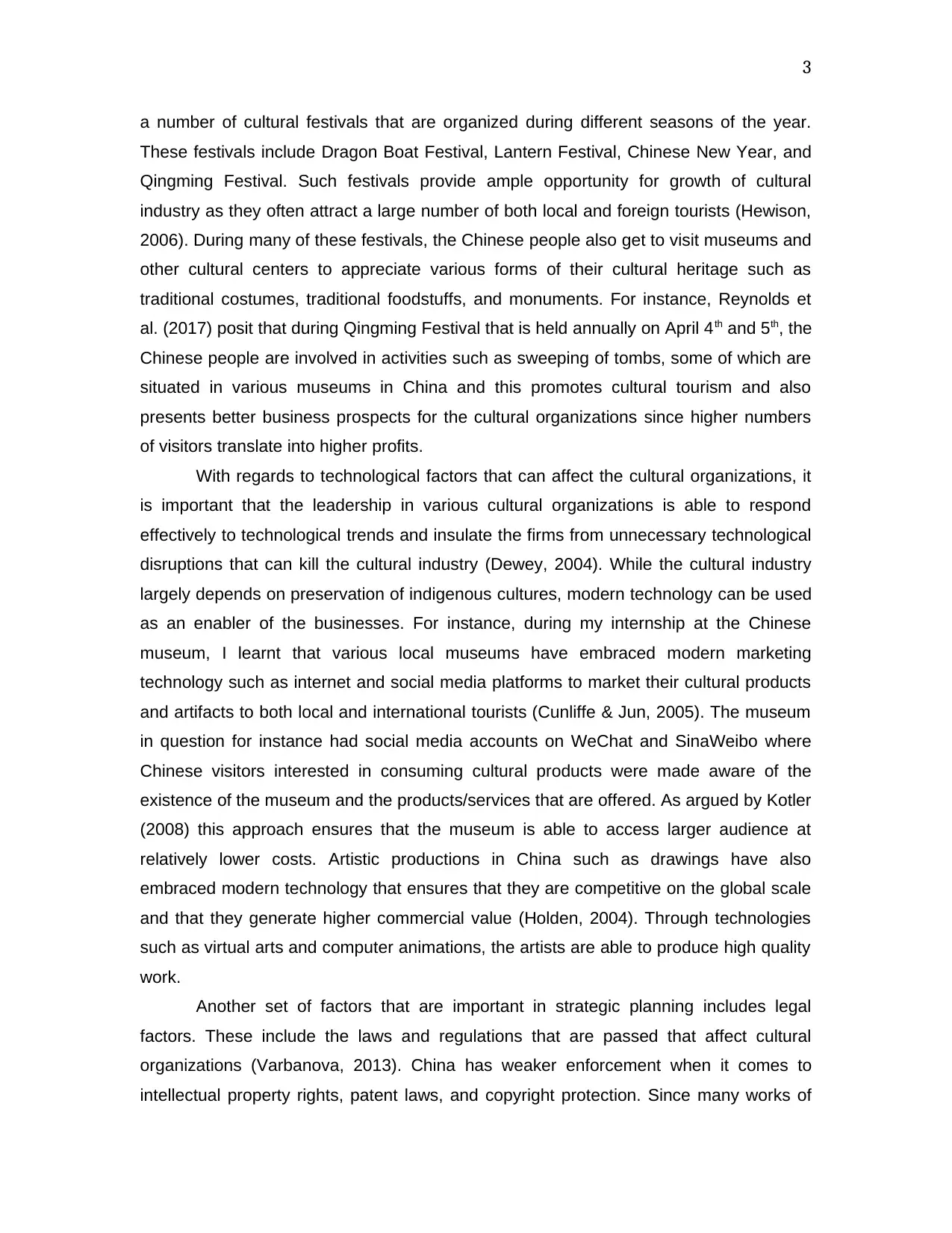
a number of cultural festivals that are organized during different seasons of the year.
These festivals include Dragon Boat Festival, Lantern Festival, Chinese New Year, and
Qingming Festival. Such festivals provide ample opportunity for growth of cultural
industry as they often attract a large number of both local and foreign tourists (Hewison,
2006). During many of these festivals, the Chinese people also get to visit museums and
other cultural centers to appreciate various forms of their cultural heritage such as
traditional costumes, traditional foodstuffs, and monuments. For instance, Reynolds et
al. (2017) posit that during Qingming Festival that is held annually on April 4th and 5th, the
Chinese people are involved in activities such as sweeping of tombs, some of which are
situated in various museums in China and this promotes cultural tourism and also
presents better business prospects for the cultural organizations since higher numbers
of visitors translate into higher profits.
With regards to technological factors that can affect the cultural organizations, it
is important that the leadership in various cultural organizations is able to respond
effectively to technological trends and insulate the firms from unnecessary technological
disruptions that can kill the cultural industry (Dewey, 2004). While the cultural industry
largely depends on preservation of indigenous cultures, modern technology can be used
as an enabler of the businesses. For instance, during my internship at the Chinese
museum, I learnt that various local museums have embraced modern marketing
technology such as internet and social media platforms to market their cultural products
and artifacts to both local and international tourists (Cunliffe & Jun, 2005). The museum
in question for instance had social media accounts on WeChat and SinaWeibo where
Chinese visitors interested in consuming cultural products were made aware of the
existence of the museum and the products/services that are offered. As argued by Kotler
(2008) this approach ensures that the museum is able to access larger audience at
relatively lower costs. Artistic productions in China such as drawings have also
embraced modern technology that ensures that they are competitive on the global scale
and that they generate higher commercial value (Holden, 2004). Through technologies
such as virtual arts and computer animations, the artists are able to produce high quality
work.
Another set of factors that are important in strategic planning includes legal
factors. These include the laws and regulations that are passed that affect cultural
organizations (Varbanova, 2013). China has weaker enforcement when it comes to
intellectual property rights, patent laws, and copyright protection. Since many works of
3
These festivals include Dragon Boat Festival, Lantern Festival, Chinese New Year, and
Qingming Festival. Such festivals provide ample opportunity for growth of cultural
industry as they often attract a large number of both local and foreign tourists (Hewison,
2006). During many of these festivals, the Chinese people also get to visit museums and
other cultural centers to appreciate various forms of their cultural heritage such as
traditional costumes, traditional foodstuffs, and monuments. For instance, Reynolds et
al. (2017) posit that during Qingming Festival that is held annually on April 4th and 5th, the
Chinese people are involved in activities such as sweeping of tombs, some of which are
situated in various museums in China and this promotes cultural tourism and also
presents better business prospects for the cultural organizations since higher numbers
of visitors translate into higher profits.
With regards to technological factors that can affect the cultural organizations, it
is important that the leadership in various cultural organizations is able to respond
effectively to technological trends and insulate the firms from unnecessary technological
disruptions that can kill the cultural industry (Dewey, 2004). While the cultural industry
largely depends on preservation of indigenous cultures, modern technology can be used
as an enabler of the businesses. For instance, during my internship at the Chinese
museum, I learnt that various local museums have embraced modern marketing
technology such as internet and social media platforms to market their cultural products
and artifacts to both local and international tourists (Cunliffe & Jun, 2005). The museum
in question for instance had social media accounts on WeChat and SinaWeibo where
Chinese visitors interested in consuming cultural products were made aware of the
existence of the museum and the products/services that are offered. As argued by Kotler
(2008) this approach ensures that the museum is able to access larger audience at
relatively lower costs. Artistic productions in China such as drawings have also
embraced modern technology that ensures that they are competitive on the global scale
and that they generate higher commercial value (Holden, 2004). Through technologies
such as virtual arts and computer animations, the artists are able to produce high quality
work.
Another set of factors that are important in strategic planning includes legal
factors. These include the laws and regulations that are passed that affect cultural
organizations (Varbanova, 2013). China has weaker enforcement when it comes to
intellectual property rights, patent laws, and copyright protection. Since many works of
3
⊘ This is a preview!⊘
Do you want full access?
Subscribe today to unlock all pages.

Trusted by 1+ million students worldwide
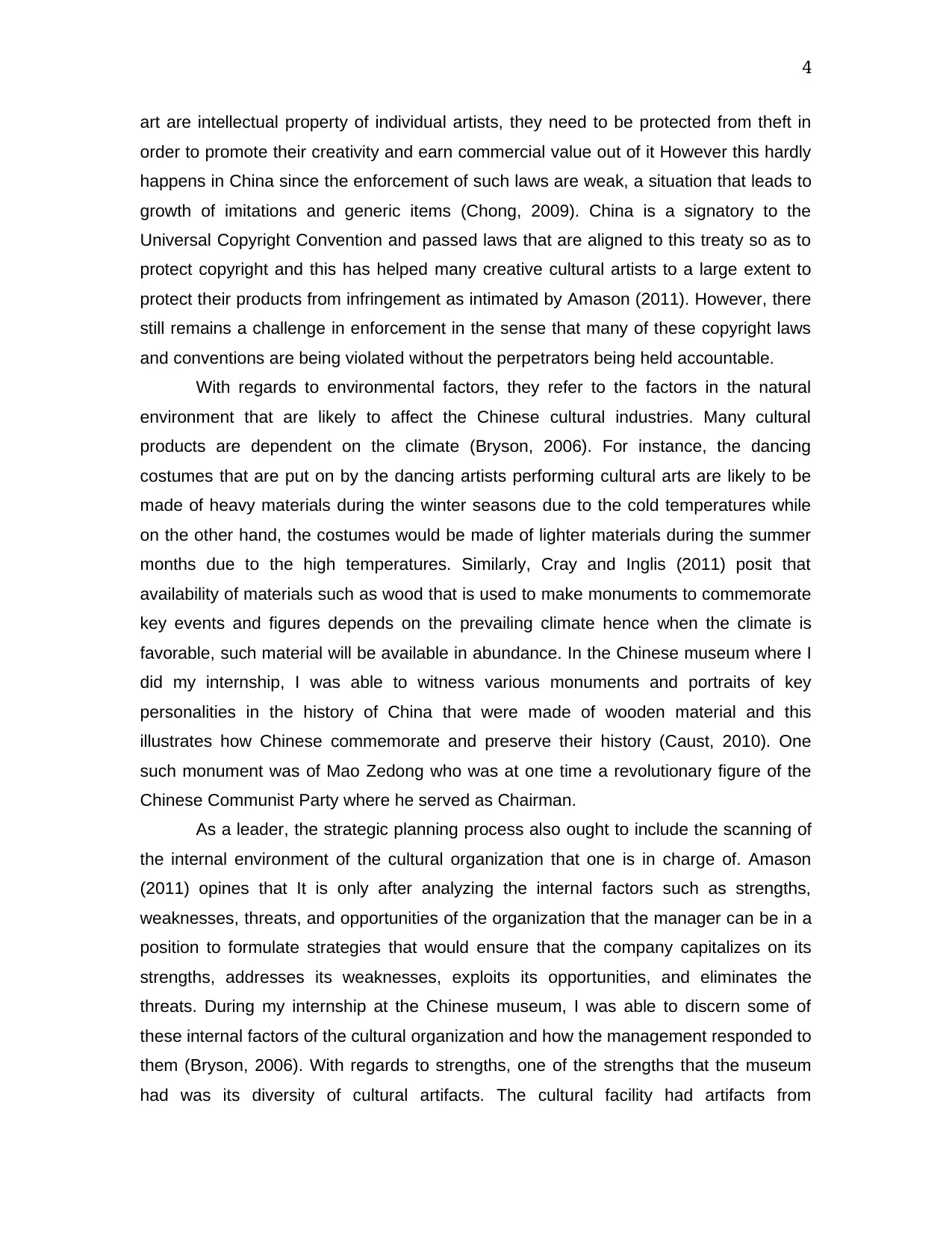
art are intellectual property of individual artists, they need to be protected from theft in
order to promote their creativity and earn commercial value out of it However this hardly
happens in China since the enforcement of such laws are weak, a situation that leads to
growth of imitations and generic items (Chong, 2009). China is a signatory to the
Universal Copyright Convention and passed laws that are aligned to this treaty so as to
protect copyright and this has helped many creative cultural artists to a large extent to
protect their products from infringement as intimated by Amason (2011). However, there
still remains a challenge in enforcement in the sense that many of these copyright laws
and conventions are being violated without the perpetrators being held accountable.
With regards to environmental factors, they refer to the factors in the natural
environment that are likely to affect the Chinese cultural industries. Many cultural
products are dependent on the climate (Bryson, 2006). For instance, the dancing
costumes that are put on by the dancing artists performing cultural arts are likely to be
made of heavy materials during the winter seasons due to the cold temperatures while
on the other hand, the costumes would be made of lighter materials during the summer
months due to the high temperatures. Similarly, Cray and Inglis (2011) posit that
availability of materials such as wood that is used to make monuments to commemorate
key events and figures depends on the prevailing climate hence when the climate is
favorable, such material will be available in abundance. In the Chinese museum where I
did my internship, I was able to witness various monuments and portraits of key
personalities in the history of China that were made of wooden material and this
illustrates how Chinese commemorate and preserve their history (Caust, 2010). One
such monument was of Mao Zedong who was at one time a revolutionary figure of the
Chinese Communist Party where he served as Chairman.
As a leader, the strategic planning process also ought to include the scanning of
the internal environment of the cultural organization that one is in charge of. Amason
(2011) opines that It is only after analyzing the internal factors such as strengths,
weaknesses, threats, and opportunities of the organization that the manager can be in a
position to formulate strategies that would ensure that the company capitalizes on its
strengths, addresses its weaknesses, exploits its opportunities, and eliminates the
threats. During my internship at the Chinese museum, I was able to discern some of
these internal factors of the cultural organization and how the management responded to
them (Bryson, 2006). With regards to strengths, one of the strengths that the museum
had was its diversity of cultural artifacts. The cultural facility had artifacts from
4
order to promote their creativity and earn commercial value out of it However this hardly
happens in China since the enforcement of such laws are weak, a situation that leads to
growth of imitations and generic items (Chong, 2009). China is a signatory to the
Universal Copyright Convention and passed laws that are aligned to this treaty so as to
protect copyright and this has helped many creative cultural artists to a large extent to
protect their products from infringement as intimated by Amason (2011). However, there
still remains a challenge in enforcement in the sense that many of these copyright laws
and conventions are being violated without the perpetrators being held accountable.
With regards to environmental factors, they refer to the factors in the natural
environment that are likely to affect the Chinese cultural industries. Many cultural
products are dependent on the climate (Bryson, 2006). For instance, the dancing
costumes that are put on by the dancing artists performing cultural arts are likely to be
made of heavy materials during the winter seasons due to the cold temperatures while
on the other hand, the costumes would be made of lighter materials during the summer
months due to the high temperatures. Similarly, Cray and Inglis (2011) posit that
availability of materials such as wood that is used to make monuments to commemorate
key events and figures depends on the prevailing climate hence when the climate is
favorable, such material will be available in abundance. In the Chinese museum where I
did my internship, I was able to witness various monuments and portraits of key
personalities in the history of China that were made of wooden material and this
illustrates how Chinese commemorate and preserve their history (Caust, 2010). One
such monument was of Mao Zedong who was at one time a revolutionary figure of the
Chinese Communist Party where he served as Chairman.
As a leader, the strategic planning process also ought to include the scanning of
the internal environment of the cultural organization that one is in charge of. Amason
(2011) opines that It is only after analyzing the internal factors such as strengths,
weaknesses, threats, and opportunities of the organization that the manager can be in a
position to formulate strategies that would ensure that the company capitalizes on its
strengths, addresses its weaknesses, exploits its opportunities, and eliminates the
threats. During my internship at the Chinese museum, I was able to discern some of
these internal factors of the cultural organization and how the management responded to
them (Bryson, 2006). With regards to strengths, one of the strengths that the museum
had was its diversity of cultural artifacts. The cultural facility had artifacts from
4
Paraphrase This Document
Need a fresh take? Get an instant paraphrase of this document with our AI Paraphraser
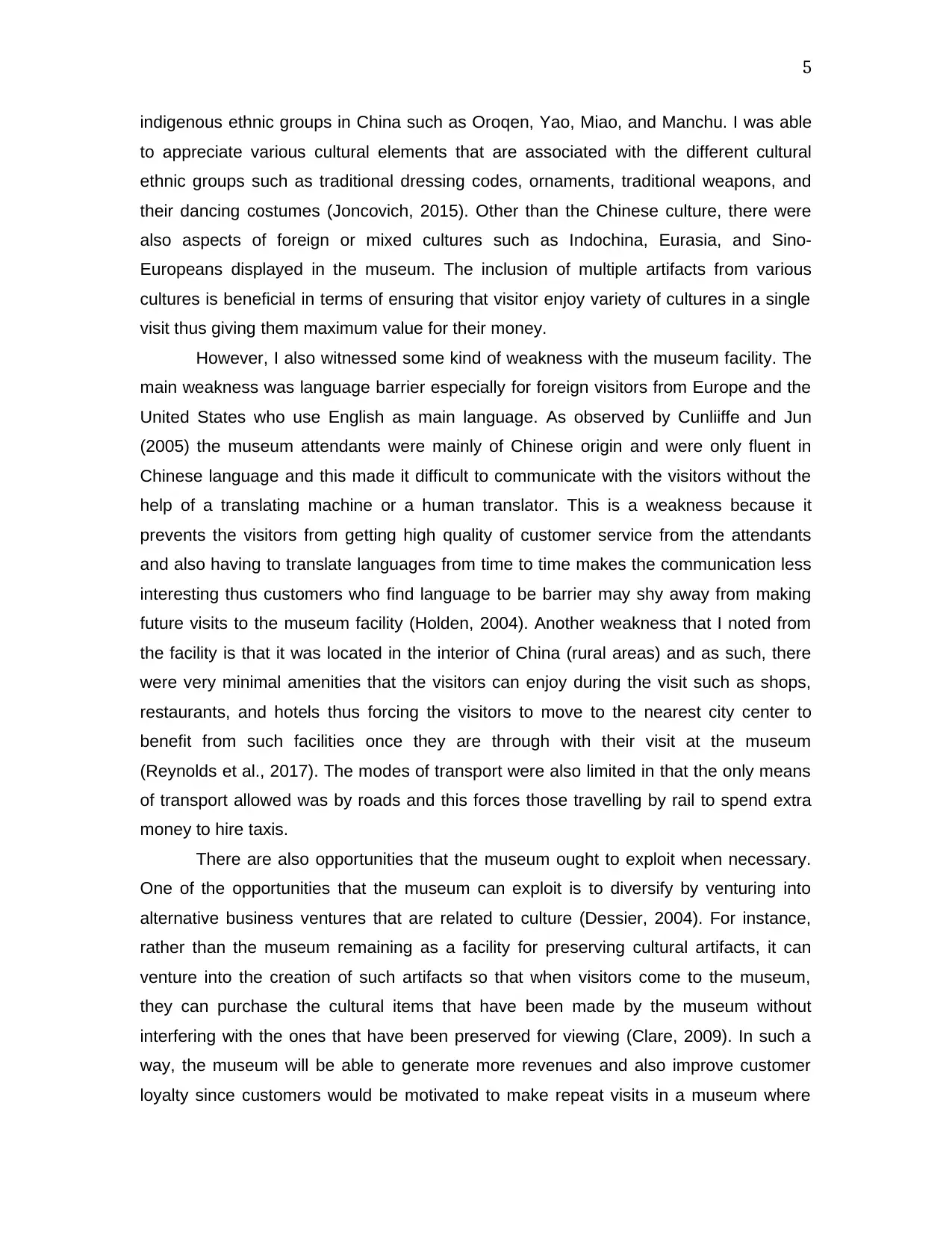
indigenous ethnic groups in China such as Oroqen, Yao, Miao, and Manchu. I was able
to appreciate various cultural elements that are associated with the different cultural
ethnic groups such as traditional dressing codes, ornaments, traditional weapons, and
their dancing costumes (Joncovich, 2015). Other than the Chinese culture, there were
also aspects of foreign or mixed cultures such as Indochina, Eurasia, and Sino-
Europeans displayed in the museum. The inclusion of multiple artifacts from various
cultures is beneficial in terms of ensuring that visitor enjoy variety of cultures in a single
visit thus giving them maximum value for their money.
However, I also witnessed some kind of weakness with the museum facility. The
main weakness was language barrier especially for foreign visitors from Europe and the
United States who use English as main language. As observed by Cunliiffe and Jun
(2005) the museum attendants were mainly of Chinese origin and were only fluent in
Chinese language and this made it difficult to communicate with the visitors without the
help of a translating machine or a human translator. This is a weakness because it
prevents the visitors from getting high quality of customer service from the attendants
and also having to translate languages from time to time makes the communication less
interesting thus customers who find language to be barrier may shy away from making
future visits to the museum facility (Holden, 2004). Another weakness that I noted from
the facility is that it was located in the interior of China (rural areas) and as such, there
were very minimal amenities that the visitors can enjoy during the visit such as shops,
restaurants, and hotels thus forcing the visitors to move to the nearest city center to
benefit from such facilities once they are through with their visit at the museum
(Reynolds et al., 2017). The modes of transport were also limited in that the only means
of transport allowed was by roads and this forces those travelling by rail to spend extra
money to hire taxis.
There are also opportunities that the museum ought to exploit when necessary.
One of the opportunities that the museum can exploit is to diversify by venturing into
alternative business ventures that are related to culture (Dessier, 2004). For instance,
rather than the museum remaining as a facility for preserving cultural artifacts, it can
venture into the creation of such artifacts so that when visitors come to the museum,
they can purchase the cultural items that have been made by the museum without
interfering with the ones that have been preserved for viewing (Clare, 2009). In such a
way, the museum will be able to generate more revenues and also improve customer
loyalty since customers would be motivated to make repeat visits in a museum where
5
to appreciate various cultural elements that are associated with the different cultural
ethnic groups such as traditional dressing codes, ornaments, traditional weapons, and
their dancing costumes (Joncovich, 2015). Other than the Chinese culture, there were
also aspects of foreign or mixed cultures such as Indochina, Eurasia, and Sino-
Europeans displayed in the museum. The inclusion of multiple artifacts from various
cultures is beneficial in terms of ensuring that visitor enjoy variety of cultures in a single
visit thus giving them maximum value for their money.
However, I also witnessed some kind of weakness with the museum facility. The
main weakness was language barrier especially for foreign visitors from Europe and the
United States who use English as main language. As observed by Cunliiffe and Jun
(2005) the museum attendants were mainly of Chinese origin and were only fluent in
Chinese language and this made it difficult to communicate with the visitors without the
help of a translating machine or a human translator. This is a weakness because it
prevents the visitors from getting high quality of customer service from the attendants
and also having to translate languages from time to time makes the communication less
interesting thus customers who find language to be barrier may shy away from making
future visits to the museum facility (Holden, 2004). Another weakness that I noted from
the facility is that it was located in the interior of China (rural areas) and as such, there
were very minimal amenities that the visitors can enjoy during the visit such as shops,
restaurants, and hotels thus forcing the visitors to move to the nearest city center to
benefit from such facilities once they are through with their visit at the museum
(Reynolds et al., 2017). The modes of transport were also limited in that the only means
of transport allowed was by roads and this forces those travelling by rail to spend extra
money to hire taxis.
There are also opportunities that the museum ought to exploit when necessary.
One of the opportunities that the museum can exploit is to diversify by venturing into
alternative business ventures that are related to culture (Dessier, 2004). For instance,
rather than the museum remaining as a facility for preserving cultural artifacts, it can
venture into the creation of such artifacts so that when visitors come to the museum,
they can purchase the cultural items that have been made by the museum without
interfering with the ones that have been preserved for viewing (Clare, 2009). In such a
way, the museum will be able to generate more revenues and also improve customer
loyalty since customers would be motivated to make repeat visits in a museum where
5
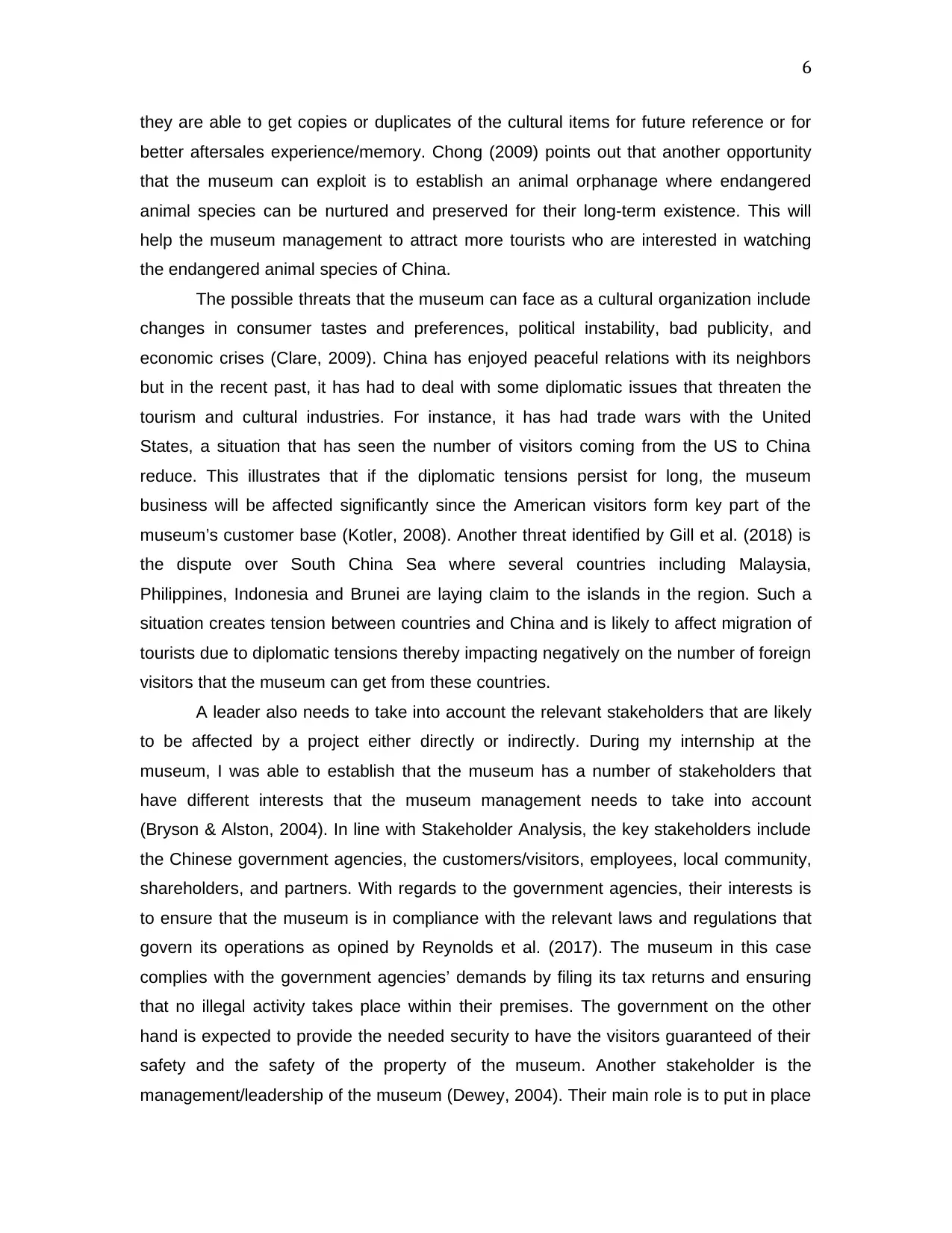
they are able to get copies or duplicates of the cultural items for future reference or for
better aftersales experience/memory. Chong (2009) points out that another opportunity
that the museum can exploit is to establish an animal orphanage where endangered
animal species can be nurtured and preserved for their long-term existence. This will
help the museum management to attract more tourists who are interested in watching
the endangered animal species of China.
The possible threats that the museum can face as a cultural organization include
changes in consumer tastes and preferences, political instability, bad publicity, and
economic crises (Clare, 2009). China has enjoyed peaceful relations with its neighbors
but in the recent past, it has had to deal with some diplomatic issues that threaten the
tourism and cultural industries. For instance, it has had trade wars with the United
States, a situation that has seen the number of visitors coming from the US to China
reduce. This illustrates that if the diplomatic tensions persist for long, the museum
business will be affected significantly since the American visitors form key part of the
museum’s customer base (Kotler, 2008). Another threat identified by Gill et al. (2018) is
the dispute over South China Sea where several countries including Malaysia,
Philippines, Indonesia and Brunei are laying claim to the islands in the region. Such a
situation creates tension between countries and China and is likely to affect migration of
tourists due to diplomatic tensions thereby impacting negatively on the number of foreign
visitors that the museum can get from these countries.
A leader also needs to take into account the relevant stakeholders that are likely
to be affected by a project either directly or indirectly. During my internship at the
museum, I was able to establish that the museum has a number of stakeholders that
have different interests that the museum management needs to take into account
(Bryson & Alston, 2004). In line with Stakeholder Analysis, the key stakeholders include
the Chinese government agencies, the customers/visitors, employees, local community,
shareholders, and partners. With regards to the government agencies, their interests is
to ensure that the museum is in compliance with the relevant laws and regulations that
govern its operations as opined by Reynolds et al. (2017). The museum in this case
complies with the government agencies’ demands by filing its tax returns and ensuring
that no illegal activity takes place within their premises. The government on the other
hand is expected to provide the needed security to have the visitors guaranteed of their
safety and the safety of the property of the museum. Another stakeholder is the
management/leadership of the museum (Dewey, 2004). Their main role is to put in place
6
better aftersales experience/memory. Chong (2009) points out that another opportunity
that the museum can exploit is to establish an animal orphanage where endangered
animal species can be nurtured and preserved for their long-term existence. This will
help the museum management to attract more tourists who are interested in watching
the endangered animal species of China.
The possible threats that the museum can face as a cultural organization include
changes in consumer tastes and preferences, political instability, bad publicity, and
economic crises (Clare, 2009). China has enjoyed peaceful relations with its neighbors
but in the recent past, it has had to deal with some diplomatic issues that threaten the
tourism and cultural industries. For instance, it has had trade wars with the United
States, a situation that has seen the number of visitors coming from the US to China
reduce. This illustrates that if the diplomatic tensions persist for long, the museum
business will be affected significantly since the American visitors form key part of the
museum’s customer base (Kotler, 2008). Another threat identified by Gill et al. (2018) is
the dispute over South China Sea where several countries including Malaysia,
Philippines, Indonesia and Brunei are laying claim to the islands in the region. Such a
situation creates tension between countries and China and is likely to affect migration of
tourists due to diplomatic tensions thereby impacting negatively on the number of foreign
visitors that the museum can get from these countries.
A leader also needs to take into account the relevant stakeholders that are likely
to be affected by a project either directly or indirectly. During my internship at the
museum, I was able to establish that the museum has a number of stakeholders that
have different interests that the museum management needs to take into account
(Bryson & Alston, 2004). In line with Stakeholder Analysis, the key stakeholders include
the Chinese government agencies, the customers/visitors, employees, local community,
shareholders, and partners. With regards to the government agencies, their interests is
to ensure that the museum is in compliance with the relevant laws and regulations that
govern its operations as opined by Reynolds et al. (2017). The museum in this case
complies with the government agencies’ demands by filing its tax returns and ensuring
that no illegal activity takes place within their premises. The government on the other
hand is expected to provide the needed security to have the visitors guaranteed of their
safety and the safety of the property of the museum. Another stakeholder is the
management/leadership of the museum (Dewey, 2004). Their main role is to put in place
6
⊘ This is a preview!⊘
Do you want full access?
Subscribe today to unlock all pages.

Trusted by 1+ million students worldwide
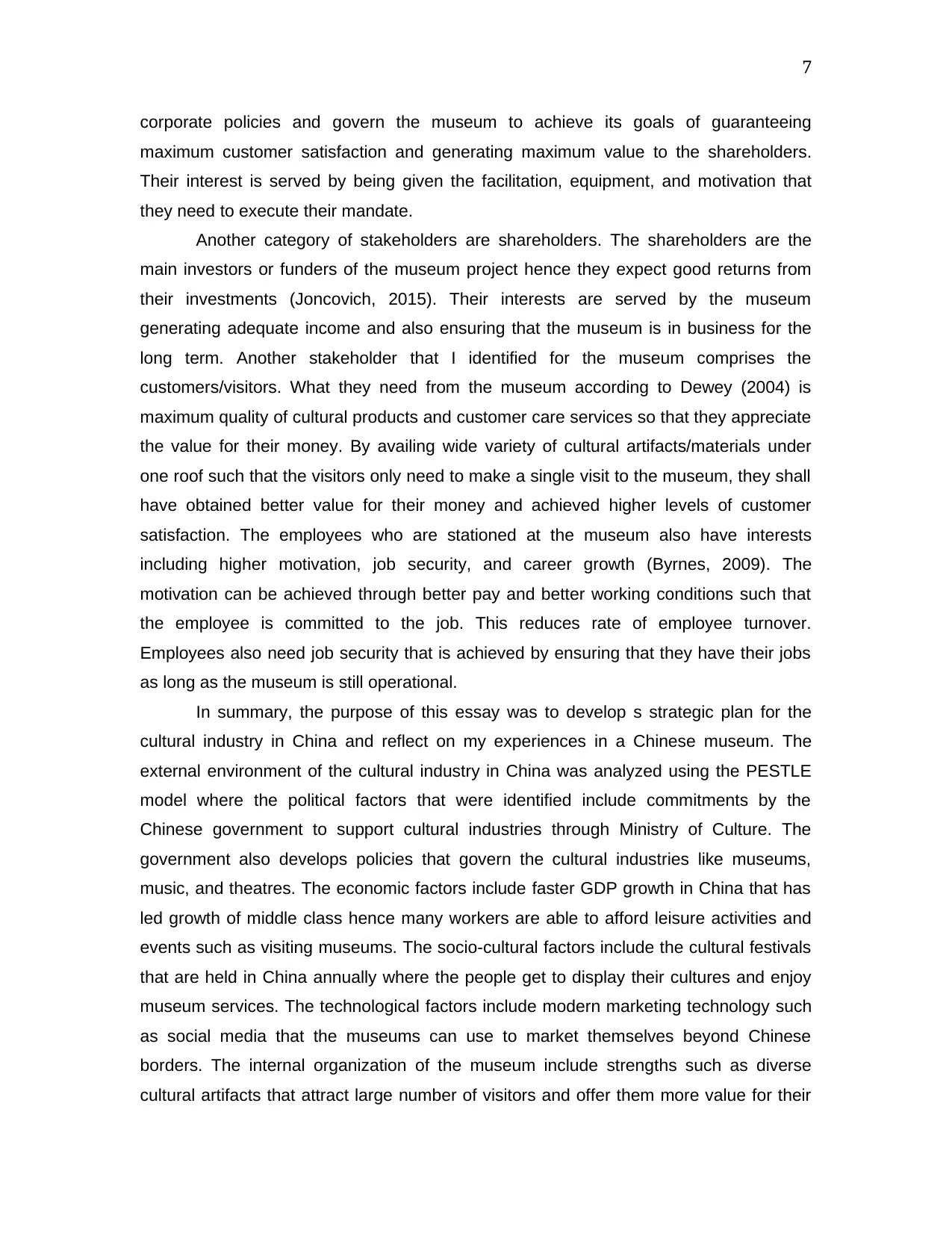
corporate policies and govern the museum to achieve its goals of guaranteeing
maximum customer satisfaction and generating maximum value to the shareholders.
Their interest is served by being given the facilitation, equipment, and motivation that
they need to execute their mandate.
Another category of stakeholders are shareholders. The shareholders are the
main investors or funders of the museum project hence they expect good returns from
their investments (Joncovich, 2015). Their interests are served by the museum
generating adequate income and also ensuring that the museum is in business for the
long term. Another stakeholder that I identified for the museum comprises the
customers/visitors. What they need from the museum according to Dewey (2004) is
maximum quality of cultural products and customer care services so that they appreciate
the value for their money. By availing wide variety of cultural artifacts/materials under
one roof such that the visitors only need to make a single visit to the museum, they shall
have obtained better value for their money and achieved higher levels of customer
satisfaction. The employees who are stationed at the museum also have interests
including higher motivation, job security, and career growth (Byrnes, 2009). The
motivation can be achieved through better pay and better working conditions such that
the employee is committed to the job. This reduces rate of employee turnover.
Employees also need job security that is achieved by ensuring that they have their jobs
as long as the museum is still operational.
In summary, the purpose of this essay was to develop s strategic plan for the
cultural industry in China and reflect on my experiences in a Chinese museum. The
external environment of the cultural industry in China was analyzed using the PESTLE
model where the political factors that were identified include commitments by the
Chinese government to support cultural industries through Ministry of Culture. The
government also develops policies that govern the cultural industries like museums,
music, and theatres. The economic factors include faster GDP growth in China that has
led growth of middle class hence many workers are able to afford leisure activities and
events such as visiting museums. The socio-cultural factors include the cultural festivals
that are held in China annually where the people get to display their cultures and enjoy
museum services. The technological factors include modern marketing technology such
as social media that the museums can use to market themselves beyond Chinese
borders. The internal organization of the museum include strengths such as diverse
cultural artifacts that attract large number of visitors and offer them more value for their
7
maximum customer satisfaction and generating maximum value to the shareholders.
Their interest is served by being given the facilitation, equipment, and motivation that
they need to execute their mandate.
Another category of stakeholders are shareholders. The shareholders are the
main investors or funders of the museum project hence they expect good returns from
their investments (Joncovich, 2015). Their interests are served by the museum
generating adequate income and also ensuring that the museum is in business for the
long term. Another stakeholder that I identified for the museum comprises the
customers/visitors. What they need from the museum according to Dewey (2004) is
maximum quality of cultural products and customer care services so that they appreciate
the value for their money. By availing wide variety of cultural artifacts/materials under
one roof such that the visitors only need to make a single visit to the museum, they shall
have obtained better value for their money and achieved higher levels of customer
satisfaction. The employees who are stationed at the museum also have interests
including higher motivation, job security, and career growth (Byrnes, 2009). The
motivation can be achieved through better pay and better working conditions such that
the employee is committed to the job. This reduces rate of employee turnover.
Employees also need job security that is achieved by ensuring that they have their jobs
as long as the museum is still operational.
In summary, the purpose of this essay was to develop s strategic plan for the
cultural industry in China and reflect on my experiences in a Chinese museum. The
external environment of the cultural industry in China was analyzed using the PESTLE
model where the political factors that were identified include commitments by the
Chinese government to support cultural industries through Ministry of Culture. The
government also develops policies that govern the cultural industries like museums,
music, and theatres. The economic factors include faster GDP growth in China that has
led growth of middle class hence many workers are able to afford leisure activities and
events such as visiting museums. The socio-cultural factors include the cultural festivals
that are held in China annually where the people get to display their cultures and enjoy
museum services. The technological factors include modern marketing technology such
as social media that the museums can use to market themselves beyond Chinese
borders. The internal organization of the museum include strengths such as diverse
cultural artifacts that attract large number of visitors and offer them more value for their
7
Paraphrase This Document
Need a fresh take? Get an instant paraphrase of this document with our AI Paraphraser
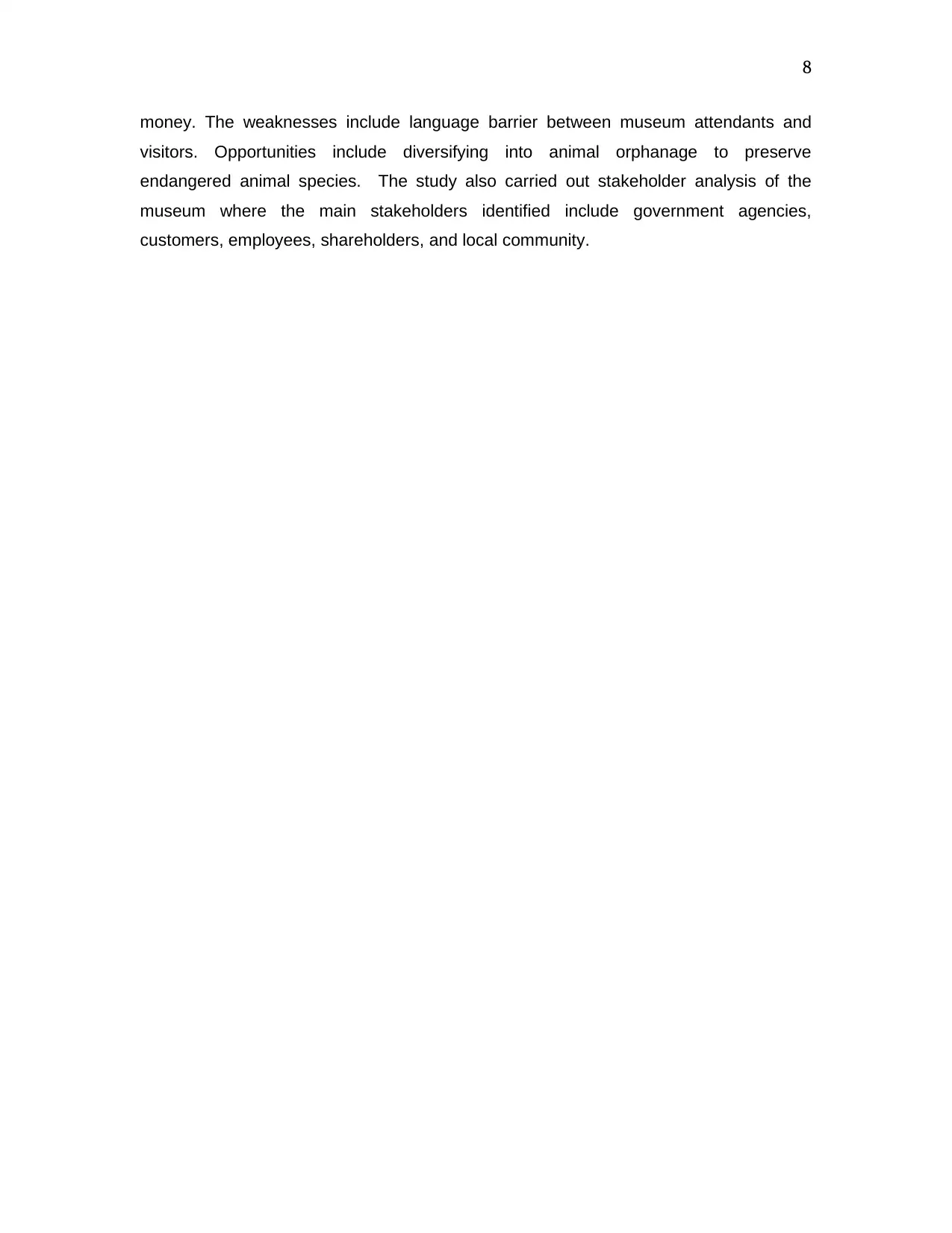
money. The weaknesses include language barrier between museum attendants and
visitors. Opportunities include diversifying into animal orphanage to preserve
endangered animal species. The study also carried out stakeholder analysis of the
museum where the main stakeholders identified include government agencies,
customers, employees, shareholders, and local community.
8
visitors. Opportunities include diversifying into animal orphanage to preserve
endangered animal species. The study also carried out stakeholder analysis of the
museum where the main stakeholders identified include government agencies,
customers, employees, shareholders, and local community.
8
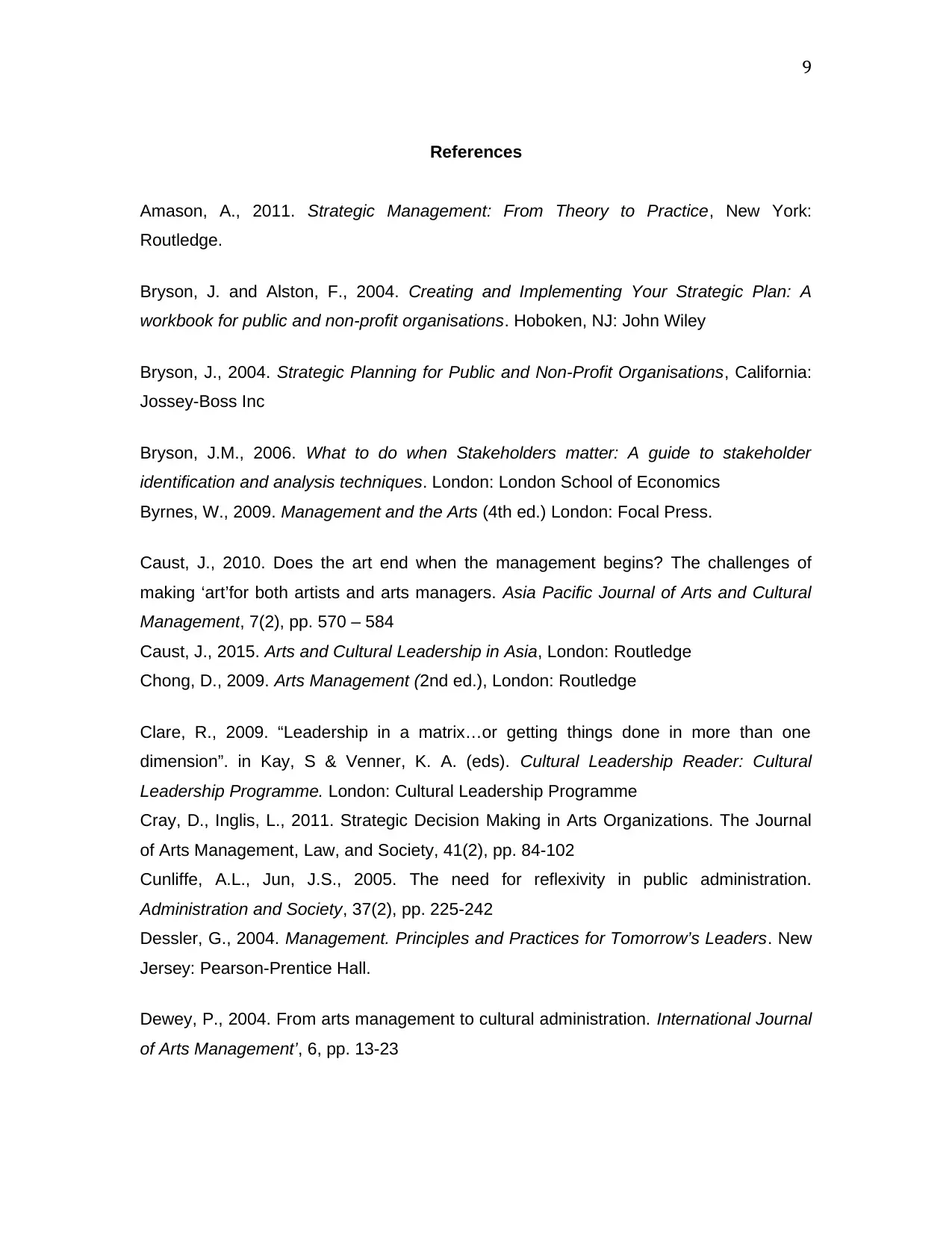
References
Amason, A., 2011. Strategic Management: From Theory to Practice, New York:
Routledge.
Bryson, J. and Alston, F., 2004. Creating and Implementing Your Strategic Plan: A
workbook for public and non-profit organisations. Hoboken, NJ: John Wiley
Bryson, J., 2004. Strategic Planning for Public and Non-Profit Organisations, California:
Jossey-Boss Inc
Bryson, J.M., 2006. What to do when Stakeholders matter: A guide to stakeholder
identification and analysis techniques. London: London School of Economics
Byrnes, W., 2009. Management and the Arts (4th ed.) London: Focal Press.
Caust, J., 2010. Does the art end when the management begins? The challenges of
making ‘art’for both artists and arts managers. Asia Pacific Journal of Arts and Cultural
Management, 7(2), pp. 570 – 584
Caust, J., 2015. Arts and Cultural Leadership in Asia, London: Routledge
Chong, D., 2009. Arts Management (2nd ed.), London: Routledge
Clare, R., 2009. “Leadership in a matrix…or getting things done in more than one
dimension”. in Kay, S & Venner, K. A. (eds). Cultural Leadership Reader: Cultural
Leadership Programme. London: Cultural Leadership Programme
Cray, D., Inglis, L., 2011. Strategic Decision Making in Arts Organizations. The Journal
of Arts Management, Law, and Society, 41(2), pp. 84-102
Cunliffe, A.L., Jun, J.S., 2005. The need for reflexivity in public administration.
Administration and Society, 37(2), pp. 225-242
Dessler, G., 2004. Management. Principles and Practices for Tomorrow’s Leaders. New
Jersey: Pearson-Prentice Hall.
Dewey, P., 2004. From arts management to cultural administration. International Journal
of Arts Management’, 6, pp. 13-23
9
Amason, A., 2011. Strategic Management: From Theory to Practice, New York:
Routledge.
Bryson, J. and Alston, F., 2004. Creating and Implementing Your Strategic Plan: A
workbook for public and non-profit organisations. Hoboken, NJ: John Wiley
Bryson, J., 2004. Strategic Planning for Public and Non-Profit Organisations, California:
Jossey-Boss Inc
Bryson, J.M., 2006. What to do when Stakeholders matter: A guide to stakeholder
identification and analysis techniques. London: London School of Economics
Byrnes, W., 2009. Management and the Arts (4th ed.) London: Focal Press.
Caust, J., 2010. Does the art end when the management begins? The challenges of
making ‘art’for both artists and arts managers. Asia Pacific Journal of Arts and Cultural
Management, 7(2), pp. 570 – 584
Caust, J., 2015. Arts and Cultural Leadership in Asia, London: Routledge
Chong, D., 2009. Arts Management (2nd ed.), London: Routledge
Clare, R., 2009. “Leadership in a matrix…or getting things done in more than one
dimension”. in Kay, S & Venner, K. A. (eds). Cultural Leadership Reader: Cultural
Leadership Programme. London: Cultural Leadership Programme
Cray, D., Inglis, L., 2011. Strategic Decision Making in Arts Organizations. The Journal
of Arts Management, Law, and Society, 41(2), pp. 84-102
Cunliffe, A.L., Jun, J.S., 2005. The need for reflexivity in public administration.
Administration and Society, 37(2), pp. 225-242
Dessler, G., 2004. Management. Principles and Practices for Tomorrow’s Leaders. New
Jersey: Pearson-Prentice Hall.
Dewey, P., 2004. From arts management to cultural administration. International Journal
of Arts Management’, 6, pp. 13-23
9
⊘ This is a preview!⊘
Do you want full access?
Subscribe today to unlock all pages.

Trusted by 1+ million students worldwide

Gill, C., Gardner, W., Claeys, J., & Vangronsvelt, K., 2018. Using theory on authentic
leadership to build a strong human resource management system. Human Resource
Management Review, 28(3), 304-318
Hewison, R., 2006. Not a Slideshow: Leadership and Cultural Value. London: Demos
Holden, J., 2004. Capturing Cultural Value, how culture has become a tool for
government policy. London: DEMOS
Jancovich, L., 2015. Breaking Down the Fourth Wall in Arts Management: The
Implications of Engaging Users. International Journal of Arts Management, 18(1), pp.14
– 28
Kotler, N., 2008. Museum marketing and strategy: designing missions, building
audiences, generating revenue and resources, California: Josey Bass Inc.
Morse, N., & Munro, E., 2015. Museums’ community engagement schemes, austerity
and practices of care in two local museum services’, Social & Cultural Geography, pp. 1-
22
Reynolds, S., Tonks, A., and Macneill, K,, 2017. Collaborative Leadership in the Arts as
a Unique Form of Dual Leadership. The Journal of Arts Management Law and Society,
47(4), pp. 1-16
Varbanova, L., 2013. Strategic Management in the arts. London: Routledge
10
leadership to build a strong human resource management system. Human Resource
Management Review, 28(3), 304-318
Hewison, R., 2006. Not a Slideshow: Leadership and Cultural Value. London: Demos
Holden, J., 2004. Capturing Cultural Value, how culture has become a tool for
government policy. London: DEMOS
Jancovich, L., 2015. Breaking Down the Fourth Wall in Arts Management: The
Implications of Engaging Users. International Journal of Arts Management, 18(1), pp.14
– 28
Kotler, N., 2008. Museum marketing and strategy: designing missions, building
audiences, generating revenue and resources, California: Josey Bass Inc.
Morse, N., & Munro, E., 2015. Museums’ community engagement schemes, austerity
and practices of care in two local museum services’, Social & Cultural Geography, pp. 1-
22
Reynolds, S., Tonks, A., and Macneill, K,, 2017. Collaborative Leadership in the Arts as
a Unique Form of Dual Leadership. The Journal of Arts Management Law and Society,
47(4), pp. 1-16
Varbanova, L., 2013. Strategic Management in the arts. London: Routledge
10
1 out of 10
Related Documents
Your All-in-One AI-Powered Toolkit for Academic Success.
+13062052269
info@desklib.com
Available 24*7 on WhatsApp / Email
![[object Object]](/_next/static/media/star-bottom.7253800d.svg)
Unlock your academic potential
Copyright © 2020–2025 A2Z Services. All Rights Reserved. Developed and managed by ZUCOL.




